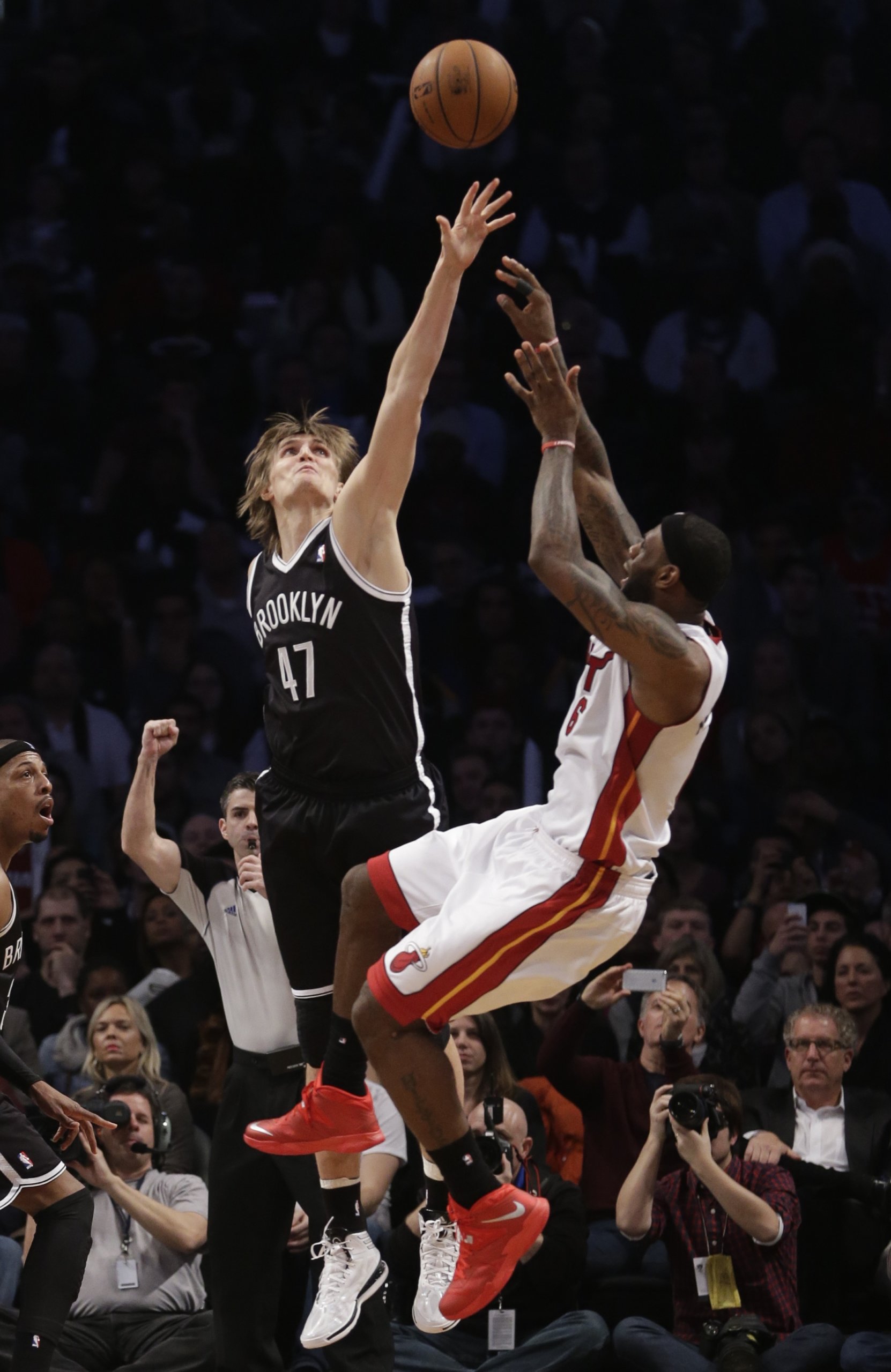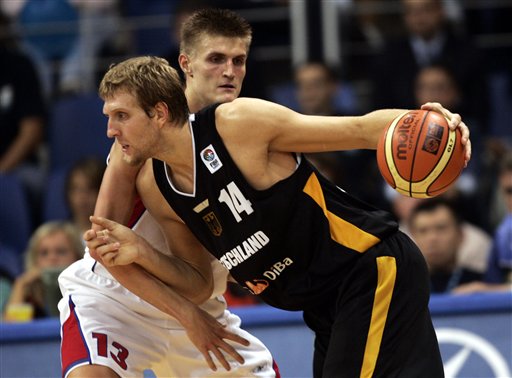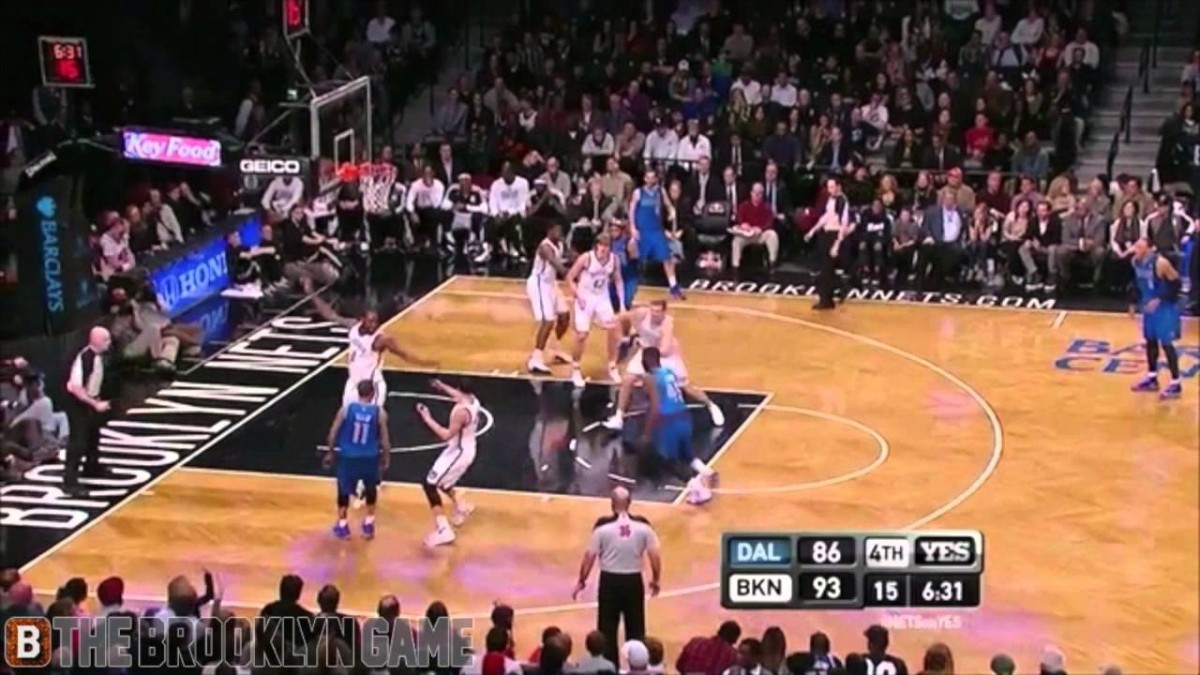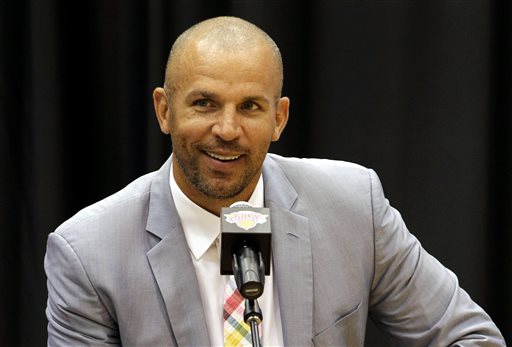
BROOKLYN, N.Y. — In a season of uncertainty for the Brooklyn Nets, there’s been one constant: the team wins when Andrei Kirilenko’s around.
Kirilenko, a 6’9″ Russian forward with arms that stretch over 7’4″ from end to end, has a subtle but perceptible impact. “He’s doing all the little things,” coach Jason Kidd says. “He’s been big for us.”
I sat down with the Brooklyn Nets forward after the team’s practice Wednesday afternoon to talk basketball, watch clips of his defense, and discuss his methods. Kirilenko had a practice jersey on, but a wrap on his sore calf, and hadn’t done any physical work. The calf injury would keep him out of the weekend’s games, losses to the Oklahoma City Thunder and Indiana Pacers, two teams with big perimeter scorers.
Heading into Monday’s game, the Nets are 12-5 when Kirilenko plays, and 8-20 when he sits.
The team just finished a film session breaking down the last two minutes of their most recent loss at that time, a 104-103 crusher at the hands of the Toronto Raptors. He was happy to review some tape, with one exception.
“Just not the last game!” he joked.
Learning defense through offense
I wanted to talk defense with Kirilenko, but much of our early conversation trends towards offense. “If you take a look, the majority — I’m not saying it’s right or wrong, but the majority of the guys, especially here in America, they’re so concentrated on (the) individual game,” he says, with just a hint of derision, before quickly hedging. “Which is alright.”
“Individual is so big in NBA and college basketball,” he continues. “Beating your man one-on-one. But sometimes it’s underestimated and undervalued, moving without the ball. If you don’t have the ball, if you’re moving and you can find the opportunities, you can be twice as effective.”
He’s not wrong. The best scorer in the NBA is the guy who’s wide open, and the player dribbling the ball is rarely the open one; the quickest, easiest points to get are to wide-open cutters and spot-up shooters. Kirilenko glides through space without the ball in his hands on both sides of the floor.
“Since the beginning of my career, I kind of played on both ends of the court, very energetic, slashing in,” he adds. He’s the anti-Joe Johnson, more focused on what he can do without the ball than with it. “I’ve never been a great shooter. I’ve always been the guy who likes to play with no ball in hand. If it needs to be, good. If I don’t have the ball, okay. I still adjust.”
Kirilenko’s right that he’s not a stellar shooter, but he gets to the basket with ease by sneaking around. Last season, he shot nearly 70 percent from the floor on plays classified as “cuts,” and a scorching 76 percent in transition, per Synergy. True to form, over 80 percent of Kirilenko’s shot attempts have come near the rim, and he’s drawn most of his fouls with off-ball basket attacks.
That’s why we’re talking about offense: how he scores informs how he defends. He’s masterful at restricting open spaces for defenders that he’s so accustomed to finding on offense. His movements can be rugged, almost spastic, but happen in a blink, and can change the game before anybody realizes what just happened.
The swat
Each player presents a different challenge, but Kirilenko is smart enough that he sees the entire court, not just his one man. When watching film in preparation for the interview, I noticed that most of Kirilenko’s blocks and steals don’t come on the guy he’s defending, they come when he’s sneaking around behind someone.
I wanted to know how he was able to anticipate those plays. After all, we’re talking about the only small forward in NBA history to lead the NBA in blocks or blocks per game, averaging 3.3 per game in 2004-05 and racking up 220 more blocks in 2005-06.
“It’s feeling,” Kirilenko tells me. “Reading the game, and being in the right place at the right time. Your athletic ability. But definitely, if you can read the game, and play with no ball, and kind of be in the right place at the right time, or create the opportunity to be in the right place at the right time, I think it’s worth a lot.”
That’s what happened on one of Kirilenko’s biggest defensive stops this season — a monster block on DeJuan Blair that earned the YES Mo Slow-Mo camera treatment. He wasn’t guarding Blair; he wasn’t even the first help defender. That was Mirza Teletovic, who slid down after a screen took Andray Blatche away.
Since Blair thought he had just one man to beat, Kirilenko surmised that Blair thought his path to the basket was a solid one. Blair was wrong.
Kirilenko’s narration: Mirza (Teletovic) was guarding Blair, and I’ve seen he kind of get him. Because when the player’s playing one-on-one, it’s almost 85-90% that offensive player will beat the defensive player. Because he’s got a first step. He knows what he’s going to do, the defensive player doesn’t know what he’s going to do. So every time when he’s playing one-on-one and he’s so concentrated on his defense, he don’t see the guy who’s coming from behind. He doesn’t see the help coming. I mean some of the guys do, but in this particular situation, I think he was so involved with beating Mirza, and he beat him, but he doesn’t see that help coming.
Defending Durant
Kirilenko is astute at understanding player tendencies, forcing them into unfavorable situations. For instance, when defending Durant, Kirilenko “fronts” him all over the floor, standing between him and the player with the ball. He works to make Durant catch the ball, whether that’s under the basket or eighteen feet out.
I ask him why he does that, and on cue, he gives a thoughtful, all-encompassing response.
Kirilenko’s narration: Definitely it’s tough to pass over me. When I’m fronting the guy, it makes catching the ball harder. If he just get the ball, easy, he’s got that freedom of movement. He knows what he’s going to do. But if he fights to get the pass first, it’s just in his mind, ‘I have to fight, then I finally got that ball,’ you don’t have the quick second to get that decision. I mean, some of the great players do. Kevin he’s great at those decisions, but you make his job way harder.
You won’t let him get the ball where he wants it, he just got it in the wrong position, he’s not facing you. He needs to take the time to face you, which he’ll still do. But he spends time. He wastes his time on the turn, and all the other guys are sitting, waiting for him, and all our guys get into help. If he got it right away, he just starts playing, and he can see all the floor.
Defending Carmelo
After watching his strategies on Durant, the conversation turned to New York Knicks forward Carmelo Anthony, the reigning NBA scoring champion.
If Durant is a pure sniper, Carmelo Anthony is a wrecking ball, taking down defenders in his path to the basket. Kirilenko can’t play Anthony like he plays Durant; if he did, he’d play right into Anthony’s strengths. Instead of fronting Anthony, Kirilenko pushes him out of the paint, making him catch the ball away from the basket. He wants to make Anthony play Durant’s jump-shooting game. It’s just math, and he’s playing the percentages.
It’s nearly impossible to stop the best, and Anthony doesn’t turn into a jump shooter on this play. Sure enough, he barrels into the paint. But Kirilenko was able to lead him into the help, and force him into a bad decision. Ultimately, that’s the goal: in a game decided by inches and split-second choices, every bad decision helps your chances.
Kirilenko’s narration: Carmelo is more aggressive with the ball in order to get into the paint. He wants to get that contact, he wants to get inside, he wants to be aggressive on the block and get it in, get it in, always follow his own shot, follow his own, kind of force his body. Every player, you have to know them. Playing against Carmelo, Kevin, LeBron, you know them over the years, they still have tendencies. Which, I have tendencies defensively and offensively so we’re playing the game. Who presents the bad opportunity rather than good opportunity to them, to pick that bad choice instead of the good choice.
(Create) Bad decisions. And they still can come out to great shot or great make after that! But you’re trying to lower that percentage and lower the chance to get them the great shot they want.
The risk
He’s a master of risk on the court, but understands it’s a tricky balance. “I wouldn’t say I’m too risky, but I’m definitely risky at the point when I need to be risky,” Kirilenko says. “It’s not that I’m risking every time. Like if I have Dirk, I will not go help on somebody else, I will stay with him. But if I’ve got somebody who’s not that great a shooter, or who never got hot… now you have a chance to help from them more.”
So he won’t leave a top scorer like Dirk. He’ll later reiterate that you have to know your personnel. But he, like Joe Johnson before him, stressed the importance of time.
Kirilenko’s narration: You have to control the seconds. Look how many seconds on the clock. There’s time flying, you’re controlling it. It’s about five, six seconds, you know you have to go. If he got the ball, he doesn’t have time to pass it. Sometimes it takes courage to risk it. That’s true. You don’t want to get in a situation where you go to help and it’s a straight pass and you get punished for it. You have to kind of find the right position and the right timing to go. You can’t just run and help with no clue. It has to be right moment.
One to five
Throughout training camp and at different times throughout the season, I asked the Nets about Kirilenko’s impact. Most of them gave the standardized answer you’d expect: he’s a great defender, he’s a smart player, he does all the little things. But one phrase kept popping up: “One to Five.” The Nets see Kirilenko as someone who can defend ones (point guards) all the way up to fives (centers).
Kirilenko’s defensive stops in the last two seasons include a wide array of names from every position: point guard Stephen Curry, cyborg LeBron James, unique shooter Dirk Nowitzki, scoring machine Kevin Durant, all the way up to post players like Javale McGee and Anthony Davis.
He knows that. He’ll pick up Stephen Curry 80 feet from the basket to run him off the three-point line as early as possible. He’ll switch on nearly any screen without losing effectiveness. He can guard centers and point guards alike. He may not be able to do it for long stretches, but in a pinch, he can “annoy” anyone.
Kirilenko’s narration: I can guard, definitely, 1 to 5. If you take a look like, if you want me to play center and guard Shaq, it’s not that I’m going to guard him all game. But for the short period of time, like let’s say it’s a quick switch, I’m pretty sure for like five, six seconds I would be able to hold him. It’s not necessarily that I will hold him as a tough guy and push him out, but I will definitely fly around him and won’t let him get the ball easily. Or foul him, or like get those little… annoy him! So he cannot get the ball easily. So same here, it’s not that I’m a 5 and I’m going to guard Birdman, or, like, Tim Duncan the whole game but for the switch and for those five or six seconds, it’s definitely a go. Green light.
You have to know your personnel. If you switch and you guard Ray Allen, you can’t go inside. You have to stay on the perimeter and cover your ground down there. So it’s game to game, you have to figure out what’s going on in the game. Who’s hot who’s not.
NOTE: some of Kirilenko’s audio was edited for space.

Kirilenko credits Utah Jazz coach Jerry Sloan for his development, with each preseason so structured and so effective that he says he could play defense with his eyes closed in Utah after Sloan’s constant schematic drilling. But he also knows the journey started long before he crossed the border.
On January 18th, 1997, one month shy of his sixteenth birthday, Kirilenko entered a Russian Superleague game with club Spartak St. Petersburg. At that moment, he became the youngest player in the history of the league, which was at that time the highest level of basketball in Russia. He played that season with the club, then spent three years with CSKA Moscow, then owned by current Nets owner Mikhail Prokhorov.
It was as a kid in Russia that Kirilenko honed his frantic, kinetic, off-ball style.
“It’s funny,” he reminisces. “When I grew up, we had a drill. Coach (would) give (us) the ball, and he said, ‘you can’t dribble.’ We’re playing basketball, but you can’t dribble the ball. Just pass and shoot.”
He smiles. “We always won the game.”

















